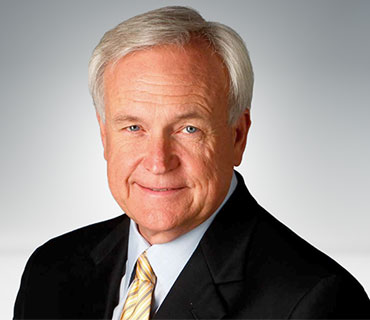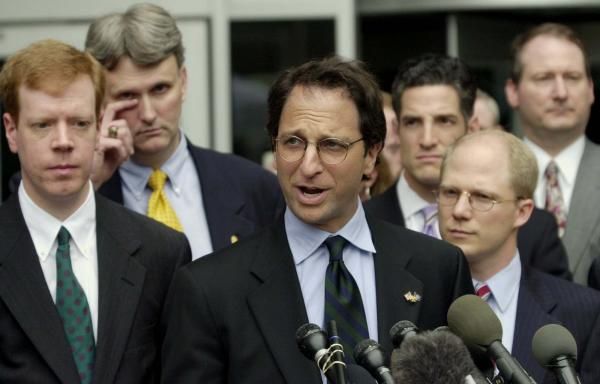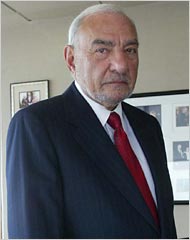 As Republican presidential nominee John McCain is doing his best to stoke public prejudice against job-creators and wealth builders, longtime Houston lawyer and businessman Bill King is promoting his new book, Saving Face (Somerset 2008), which is King’s personal history of the savings & loan crisis of the late 1980’s and early 1990’s.
As Republican presidential nominee John McCain is doing his best to stoke public prejudice against job-creators and wealth builders, longtime Houston lawyer and businessman Bill King is promoting his new book, Saving Face (Somerset 2008), which is King’s personal history of the savings & loan crisis of the late 1980’s and early 1990’s.
Ironically, McCain knows quite a bit about the back story to King’s book.
McCain was one of the Keating Five, the Congressional supporters of former Lincoln Savings & Loan chairman and CEO Charles Keating, who was convicted of various corporate fraud crimes and served four years in prison as a result of highly-stoked but substantively-thin prosecutions that were ultimately overturned on appeal.
Keating eventually pled guilty to a single count of bankruptcy fraud to limit further prison time and insulate a family member from prosecution. For a thorough review of the mendacity of the Keating prosecutions, pick up a copy of Dan Fischel‘s book, Payback: The Conspiracy to Destroy Michael Milken and his Financial Revolution (HarperCollins 1995).
King’s story is the Houston version of Keating’s and a precursor of the prosecutorial abuse that the post-Enron criminal prosecutions in Houston generated a decade later.
Not only does King do an excellent job of explaining the financial, economic, regulatory and political underpinnings of the S&L crisis, he explores how the government wielded its prosecutorial power indiscriminately to serve up scapegoats to a salivating mainstream media and an ill-informed public.
King is thinking about running for Houston mayor in 2009 and, based on the depth and perspective that he exhibits in Saving Face, King would probably be a fine mayor. The following is King’s overview of Saving Face, which I recommend highly:
These days I find myself cringing when I hear media accounts that fraudulent and greedy mortgage brokers are responsible for all of the woes of the current housing bubble and the sub-prime defaults. I do so because the recriminations are an all too familiar echo of an earlier debacle. One to which I had a ring-side seat.
Many of you who have known me for some years know that shortly after law school I made the somewhat less-than-fortuitous career decision of joining a law firm that specialized in representing savings and loans.
At the time it did not seem like a bad decision. The Houston real estate market was enjoying an unprecedented boom and the savings and loan industry had just been deregulated. Investors were clamoring to get into the business.Within a few years of joining the law firm, I began investing in savings and loans and related businesses.
By 1986, notwithstanding that I had started with barely two nickels to rub together after working my way through law school, I had built a small, but respectable, business empire consisting of savings and loan holdings, title companies, and real estate investments.
However, within a couple of years, everything I had built evaporated into thin air.The Houston market collapsed when the price of oil fell from over $34 per barrel in 1984 to $9 the next year. It did not recover to above $20 until 2002.
Manufacturing jobs in the region fell by nearly 50% and for the first time in history Texans’ personal income declined. Bankruptcies in Houston tripled between 1983 and 1987. All but one of Texas’ major banking holding companies failed. Harris County’s population actually declined from 1985 to 1989. It was the first and only time in Houston’s history that it has lost population.
If you did not live through these times, the magnitude of melt down is hard to imagine.It is certainly difficult to lose everything that you have worked for, but the environment that existed in the late 1980s and early 1990s had an even more ominous aspect.
As the public became increasingly aware that the savings and loan crisis was going to take a major taxpayer bailout, there were ever more strident cries to hold someone responsible.
The complexity of confluence of interest rates, regulatory policy, oil prices, the Tax Reform Act of 1986, and the collapse of large portions of the real estate market that actually explained the collapse was too great to be reduced to sound bites. Politicians and bureaucrats began pointing the finger at those in the industry, and soon, the “S&L crook” was born.
And there were enough egregious cases for the politicians and bureaucrats to hold up as “proof” of their argument that the “S&L crooks” caused the crisis. The proposition that fraud and insider abuse had sunk the savings and loan industry was eventually discredited.
In 1993, a National Commission concluded that fraud had caused less than 15% of the total problem. But in the heat of the moment, there was little interest in cool, scholarly reflection on the problems of the industry.
As the 1980s came to a close I watched as many friends, associates and former clients in the S&L industry were swept up in a maelstrom of civil and criminal litigation. Naively, it never occurred to me that I might be caught up in such a dispute as well. But I was.
Eventually, I prevailed in my battle with the regulators, but as you might imagine, it was an experience that left an indelible mark and from which it took me many years to recover.
For some time I have been jotting down notes for a book about these experiences. For a couple of reasons, I recently decided to finalize such a book.
First, as many of you know, I am considering a candidacy for mayor of Houston in 2009. We all know too well that “negative campaigning” has become the standard today. Certainly going bankrupt in the savings and loan business will provide potential opponents ready ammunition. So first and foremost, I want to put the issue squarely on the table.
If I decide to become a candidate, there will undoubtedly be some voters who will be troubled by these experiences. Some will believe difficult times such as the ones I went through are a crucible that better prepares a person for leadership. Most, I expect, will simply want to be advised of the facts so that they can be weighed with other issues bearing on their decision.
But beyond the potential political implications, the troubling similarities between what I saw in the S&L collapse of the 1980s and the sub-prime crisis playing out before us now demands some consideration.
It is a well worn adage, but nonetheless true, that if we do not learn from our history, we are doomed to repeat our mistakes. Perhaps relating what I saw during the saving and loan industry collapse will provide some perspective on the current financial crises.
So for these reasons I have written Saving Face: An Alternative and Personal Account of the Savings and Loan Debacle. I have attempted in the book to tell the story of what I experienced during these times, but at the same time, to place my experiences in a larger, national context. I believe my story has some relevance to anyone experiencing trying times generally, and certainly to those in the Houston real estate industry, many of whom lived through these times as I did.
Like this:
Like Loading...
 So, the shoe finally dropped on the two Bear Stearns executives who managed the two Bear hedge funds that imploded in mid-2007. A copy of the indictment is here.
So, the shoe finally dropped on the two Bear Stearns executives who managed the two Bear hedge funds that imploded in mid-2007. A copy of the indictment is here.

 As Republican presidential nominee John McCain is doing his best
As Republican presidential nominee John McCain is doing his best 





